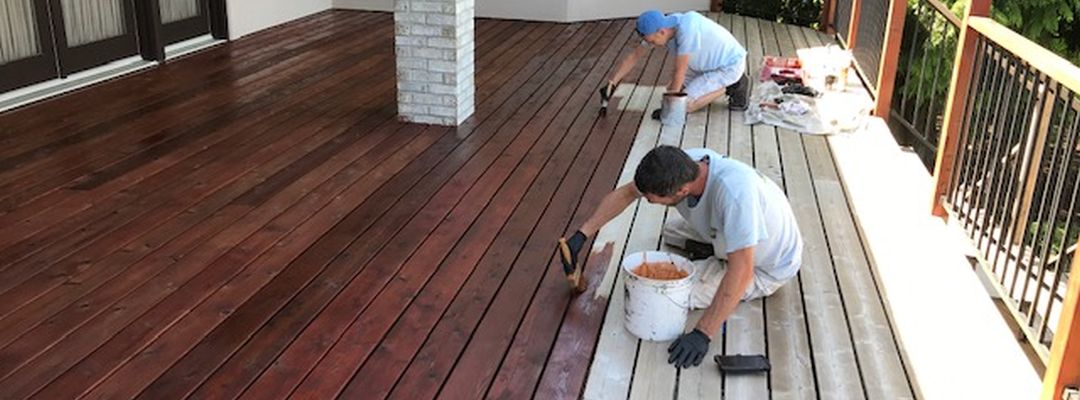Deck Discoloration 101: Whatever You Need to Know for a DIY Project
From preparing the deck surface area to choosing the right kind of discolor and mastering the application strategies, each action plays a vital function in achieving an expert finish. Join us as we unwind the important standards and insider tips for grasping the art of deck discoloration, guaranteeing an effective DIY task that will leave your deck looking impressive.
Importance of Deck Discoloration
Deck staining is a crucial maintenance job that preserves the long life and appearance of outside wood structures. Wooden decks are frequently exposed to rough aspects such as sunshine, foot, rainfall, and snow traffic, all of which can cause tear and use gradually. By applying a coat of stain to the deck's surface, you develop a safety obstacle that helps prevent dampness infiltration, UV damage, and decaying of the wood. This not only extends the lifespan of the deck yet likewise keeps its aesthetic charm.
It gives an opportunity to tailor the look of the deck by picking from a selection of discolor shades and surfaces. In significance, regular deck discoloration is a basic yet reliable method to ensure your deck stays structurally sound and aesthetically pleasing for years to come.
Deck Preparation Tips

After cleansing and fixing, sanding the deck is necessary to smooth out harsh surface areas and open up the wood's pores to better absorb the tarnish. Make use of a coarse-grit sandpaper adhered to by a finer grit for a polished surface. When the deck is tidy, dry, and smooth, safeguard any type of neighboring plants, furniture, or surface areas with a ground cloth prior to applying the deck stain. Complying with these prep work actions diligently will lead to a wonderfully discolored deck that is well-protected and aesthetically pleasing.
Choosing the Right Stain
Choosing the proper stain for your deck is a vital decision that directly impacts both its appearance and resilience. When picking the appropriate stain, there are numerous variables to think about to guarantee a successful do it yourself project.
Firstly, you need to choose between clear, semi-transparent, and solid discolorations. Transparent spots allow the all-natural grain of the timber to reveal with however offer very little defense versus UV rays and wetness. Semi-transparent stains supply a compromise in between shade and security, while strong discolorations offer the most security but cover the timber grain.
Following, take into consideration the kind of wood your deck is made of, as different spots work much better click for more with certain timber varieties. For example, cedar and redwood decks usually look ideal with a semi-transparent or clear tarnish to highlight their all-natural appeal. Pressure-treated wood could take advantage of a solid discolor to hide imperfections.
Finally, consider the environment in your area. If you experience severe wintertimes or extreme sunlight, go with a discolor with UV protection and resistance to extreme weather. By carefully thinking about these elements, you can select a stain that boosts your deck's appearances and durability.

Applying Spot Correctly
When thinking about the application of tarnish to your deck, it is vital to pay attention to the details qualities of the discolor picked and exactly how it engages with the sort of wood and environmental conditions previously pondered. Before beginning the staining procedure, make certain that the deck surface is clean, dry, and without any previous finishings or debris. It is suggested to check the picked discolor on a small unnoticeable area of the deck to guarantee compatibility and accomplish the desired shade and coating.
Apply the stain along the length of the deck boards to avoid uneven pooling - fence staining companies near me. It is important to function with the wood grain to boost the natural appeal of the deck and enable for far better infiltration of the tarnish.
Maintenance and Treatment Tips

Another vital element of deck upkeep is securing it from the aspects. Consider applying a waterproof sealer every few years to protect the timber from moisture damages. Addressing any mold or mildew without delay is crucial to avoid them from triggering architectural injury to your deck. Frequently cutting neighboring foliage can additionally stop fallen leaves and branches from accumulating on your deck and triggering potential damages.
Final Thought
To conclude, deck discoloration is a crucial action in keeping the look and long life of your outside space. By appropriately preparing the deck, choosing the right stain, applying it properly, and adhering to upkeep pointers, you can guarantee a long lasting and gorgeous coating that will last for many years ahead. Remember to frequently evaluate and care for your discolored deck to keep it looking its best.
Join us as we unravel the vital guidelines and insider suggestions for grasping the art of deck discoloration, ensuring a successful DIY task that will certainly leave your deck looking impressive. - fence staining nashville
In significance, normal deck discoloration is a simple yet effective way to guarantee your deck remains structurally audio and visually pleasing for years to come.
Once the deck is tidy, completely dry, and smooth, protect any type of nearby plants, furnishings, or surface areas with a decrease fabric before using the click to read more deck stain.Next, consider the type of timber your deck is made of, as various discolorations work better with specific timber varieties.When considering the application of tarnish to your deck, it is vital to pay close interest to the specific features of the stain picked and just how it communicates with the type of wood and ecological problems previously mulled over.